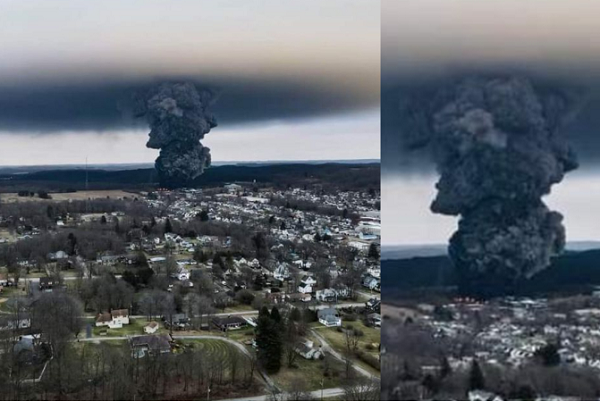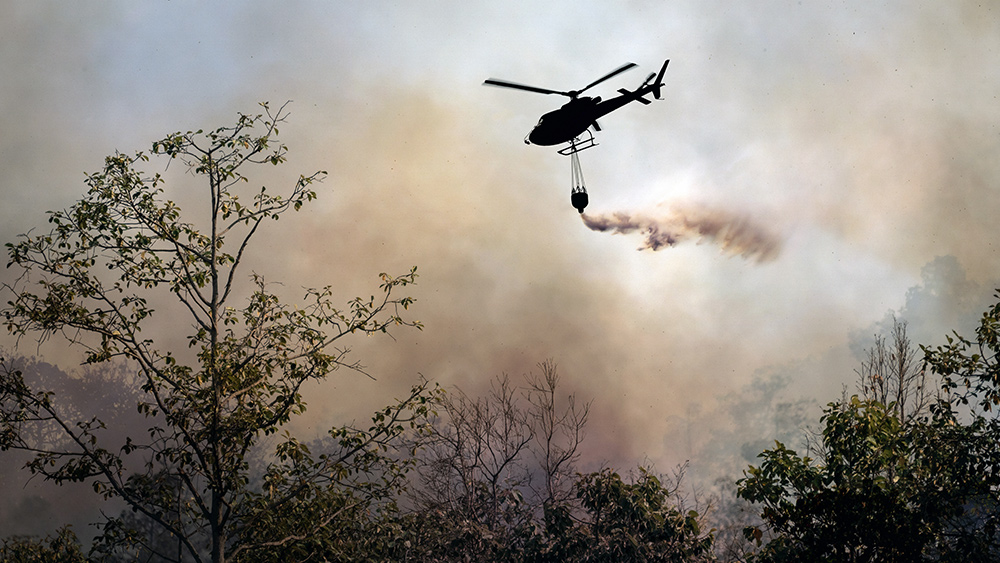
A resident who lives near the East Palestine, Ohio, site of this month's horrendous train derailment and chemical spill, said that the Environmental Protection Agency is ignoring him after he reported ash from a controlled burn of the chemicals landed all over his residence more than a mile-and-a-half away.
"Like many residents who live within a few miles of Norfolk Southern Railway’s Feb. 3 train derailment, Jerry Corbin evacuated before the railroad decided to conduct a controlled burn of five freight cars containing the toxic vinyl chloride on Feb. 6," The Epoch Times reported this week. "When he returned to his home in Darlington Township, Pennsylvania—around 1.4 miles from the crash site—Corbin discovered two surprises. Black debris that resembled ash was strewn all over his yard and on his roof, and an “undetonated blasting cap” landed in a pasture near his house."
On the night of February 3rd, a catastrophic train derailment occurred in the small village of East Palestine, Ohio. With 151 cars on board, the Norfolk Southern train derailed and caused a fire that engulfed an additional 12 cars.
Alarmingly, 11 of the derailed cars contained hazardous materials, prompting Norfolk Southern to take drastic measures to avoid a large-scale explosion. Thus, the company opted to release and burn vinyl chloride from five of the rail cars, resulting in a large plume of thick black smoke and intense flames soaring into the sky, the outlet noted.
According to witness accounts, the controlled burn was initiated by a blasting cap, a small device containing cotton and wire that is used to detonate explosives. Though the measure was intended to keep the incident under control, the destruction left behind has yet to be fully assessed. Corbin thinks a blasting cap he found on his property was meant to be used in the detonation of the rail cars.
Human knowledge is under attack! Governments and powerful corporations are using censorship to wipe out humanity's knowledge base about nutrition, herbs, self-reliance, natural immunity, food production, preparedness and much more. We are preserving human knowledge using AI technology while building the infrastructure of human freedom. Speak freely without censorship at the new decentralized, blockchain-power Brighteon.io. Explore our free, downloadable generative AI tools at Brighteon.AI. Support our efforts to build the infrastructure of human freedom by shopping at HealthRangerStore.com, featuring lab-tested, certified organic, non-GMO foods and nutritional solutions.
“It’s not real big. It would blow your hand off,” Corbin said of the blasting cap. “I contacted someone in the military and asked him about it. He said don’t have any static electricity around it, don’t drop it.”
Vinyl chloride is a substance utilized in the production of PVC pipes and other items. According to the National Cancer Institute, vinyl chloride has been connected to various cancers, including those of the brain, lungs, liver, blood, and lymphatic system.
Furthermore, the other rail cars contained various chemicals such as ethylene glycol monobutyl ether, ethylhexyl acrylate, isobutylene, and butyl acrylate, all of which are used in the manufacturing of plastic products.
“The night of the crash, my wife and I were driving into East Palestine to go to the store, and we saw the fire and the smoke,” Corbin told the outlet. “I have asthma, so even before there was an evacuation order, we packed a few bags and went to a hotel away from the area.”
Ohio Governor Mike DeWine urged individuals living within a 1-mile by 2-mile area around East Palestine, which encompasses parts of Ohio and Pennsylvania, to evacuate prior to the controlled burn.
DeWine emphasized the gravity of the situation as a "matter of life and death."
Three days later, DeWine announced during a press conference that the evacuation order was lifted, allowing residents to return to their homes. Norfolk Southern trains resumed traveling through East Palestine, and state and federal officials declared that tests confirmed the safety of the air and water.
Corbin turned 73 the day he and his wife returned to their home, on Feb. 9. During an initial conversation with the EPA, the agency said that the ash he found on his property wasn't from the rail car burn.
“Then they sent some people out, and they were astonished about what they saw,” Corbin said, noting that officials from the agency took samples before leaving.
“A few days later, some more people from the EPA stopped by and took more samples,” Corbin said. “I asked them to let me know what is in that ash before we plant our garden. We haven’t heard anything from them since.”
Sources include:
Please contact us for more information.




















